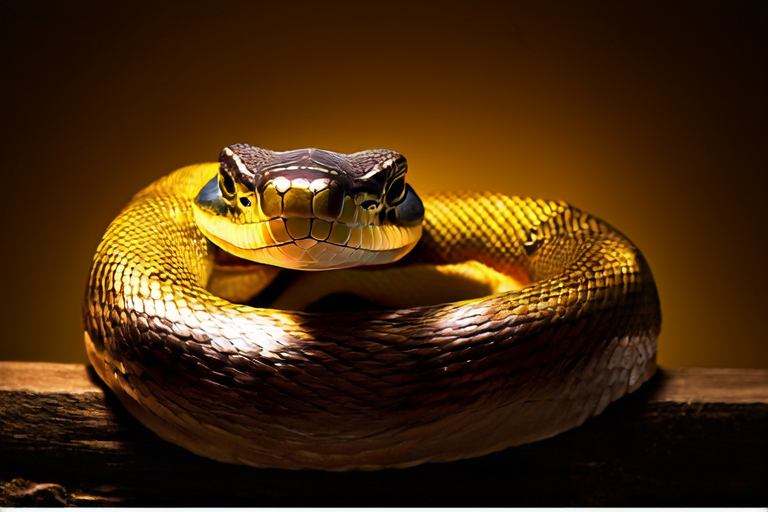The Golden Python: A Shimmering Addition to Exotic Pet Collections
The Golden Python, scientifically known as Morelia spilota spilota, is a captivating and visually stunning species of python native to Australia. Its striking golden hue, combined with its docile nature and manageable size, makes it an attractive option for those interested in exotic pets. This article delves into the unique appearance, care requirements, temperament, and legal considerations surrounding the ownership of this remarkable snake. By understanding these aspects, potential owners can ensure they provide their Golden Pythons with the best possible environment and care.
Unique Appearance
The Golden Python’s most distinguishing feature is its vivid golden coloration, which sets it apart from other pythons. This coloration is due to a genetic mutation that results in a reduced amount of melanin, leading to a bright yellow or gold appearance. While some individuals may have darker patches or stripes, many possess an almost uniform golden sheen. The scales are smooth and glossy, adding to the snake’s allure. These snakes typically grow to be between 6 and 8 feet long, though some specimens can reach up to 10 feet. Their slender build and vibrant coloring make them particularly appealing to enthusiasts of exotic pets.
Care Requirements
Providing appropriate care for a Golden Python involves creating a suitable habitat, ensuring proper nutrition, and maintaining hygiene. The enclosure should mimic the snake’s natural environment, providing ample space for movement and climbing opportunities. A terrarium measuring at least 48 inches long, 24 inches wide, and 24 inches high is recommended for adult snakes. Temperature control is crucial; the enclosure should have a warm end (between 85°F and 90°F) and a cooler end (around 75°F). Humidity levels should be maintained between 50% and 60%, which can be achieved through regular misting and the use of a water dish. Substrate options include cypress mulch, coconut fiber, or reptile carpet, all of which help maintain humidity while being easy to clean.
Feeding a Golden Python requires careful consideration. Juveniles should be fed every five to seven days, while adults can be fed once every two weeks. Prey items should be appropriately sized, usually mice or small rats for juveniles and larger rats or rabbits for adults. Overfeeding can lead to obesity, so it’s essential to monitor the snake’s weight and adjust feeding schedules accordingly. Additionally, it’s important to handle prey items humanely and ethically, sourcing them from reputable breeders or suppliers who prioritize animal welfare.
Temperament
Golden Pythons are generally calm and docile, making them relatively easy to handle compared to some other python species. They tend to be gentle and tolerant of handling, provided they are given time to acclimate to their surroundings and handlers. Regular interaction and gentle handling sessions can help build trust between the snake and its owner. However, like all animals, individual temperaments can vary, and some snakes may be more skittish or defensive. It’s crucial to approach each snake with respect and patience, allowing it to dictate the pace of interactions.
Origin and Legal Considerations
The Golden Python originates from Australia, where it inhabits a variety of habitats, including forests, woodlands, and grasslands. Due to its popularity in the exotic pet trade, strict regulations govern its importation and ownership in many countries. Before acquiring a Golden Python, prospective owners must research and comply with local laws and regulations regarding exotic pet ownership. In some regions, permits or licenses may be required, and certain restrictions may apply based on the snake’s size or age. Responsible pet ownership includes ensuring compliance with all legal requirements and understanding the long-term commitment involved in caring for these snakes.
Dietary Needs
A well-balanced diet is essential for maintaining the health and vitality of a Golden Python. As mentioned earlier, their diet primarily consists of rodents, such as mice and rats. The size of the prey item should be proportional to the snake’s girth, ensuring that it is neither too large nor too small. Over time, as the snake grows, so too will its appetite, necessitating larger prey items. It’s also important to ensure that the prey items are healthy and free from parasites or diseases that could be transmitted to the snake. Feeding live prey can pose risks to both the snake and the prey, so it is advisable to use pre-killed or frozen-thawed prey whenever possible.
Habitat Setup
Creating an optimal habitat for a Golden Python involves replicating its natural environment as closely as possible. In addition to the previously mentioned temperature and humidity controls, providing hiding spots and climbing structures is vital. These can include cork bark pieces, branches, or artificial plants. Hiding spots offer security and reduce stress, while climbing structures encourage natural behaviors and exercise. Proper ventilation is also necessary to prevent the buildup of harmful bacteria and mold. Using a secure lid or screen top ensures that the enclosure remains escape-proof while allowing for adequate air circulation.
Responsible Pet Ownership
Owning a Golden Python comes with significant responsibilities. Potential owners must commit to providing the necessary care, attention, and resources for the snake’s entire lifespan, which can exceed 20 years. This includes regular veterinary check-ups, proper feeding, and maintaining a clean and stimulating environment. It’s also important to consider the impact of owning an exotic pet on local ecosystems if the snake were to escape or be released into the wild. Responsible pet ownership means taking all precautions to prevent such occurrences and being prepared for the long-term commitment involved.
Conclusion
The Golden Python is a mesmerizing and rewarding addition to any exotic pet collection, but it requires careful consideration and commitment. Its unique appearance, manageable size, and docile temperament make it an appealing choice for enthusiasts, but the responsibility of providing appropriate care cannot be understated. By understanding the specific needs of this species and adhering to legal guidelines, potential owners can ensure that their Golden Pythons thrive in captivity. Ultimately, responsible pet ownership is key to maintaining the health and well-being of these magnificent creatures.
